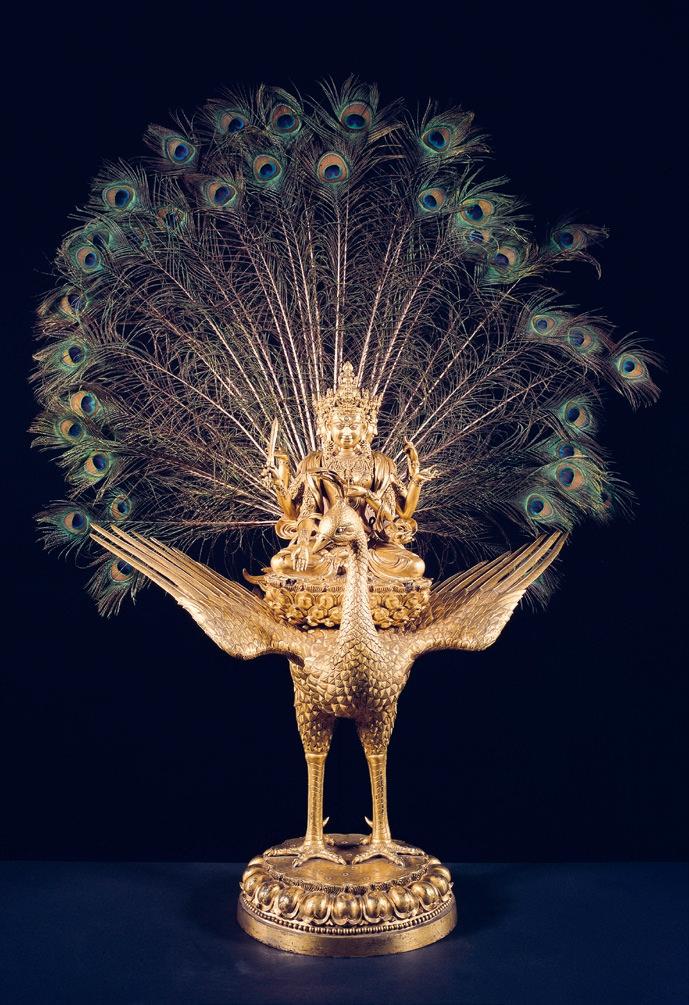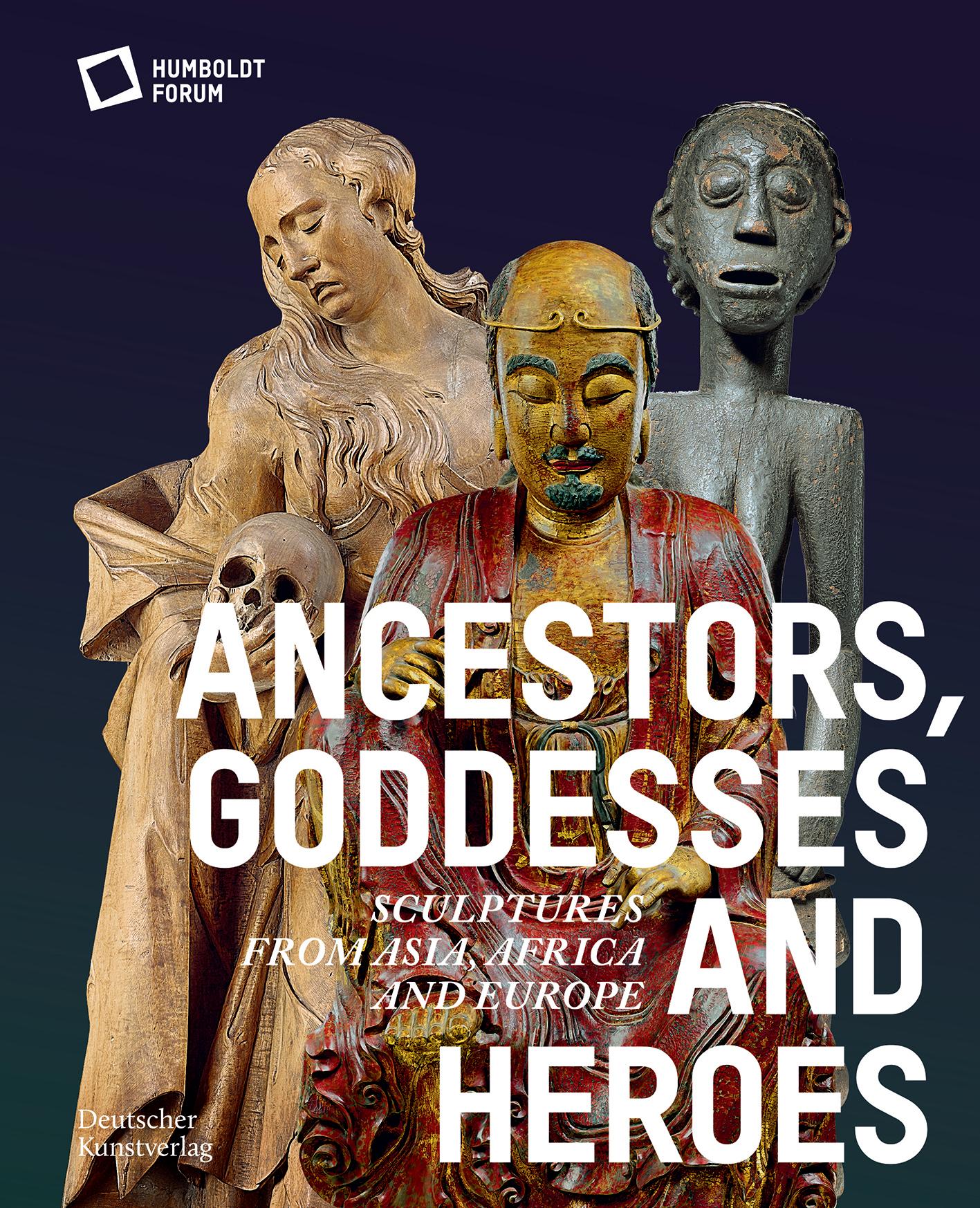
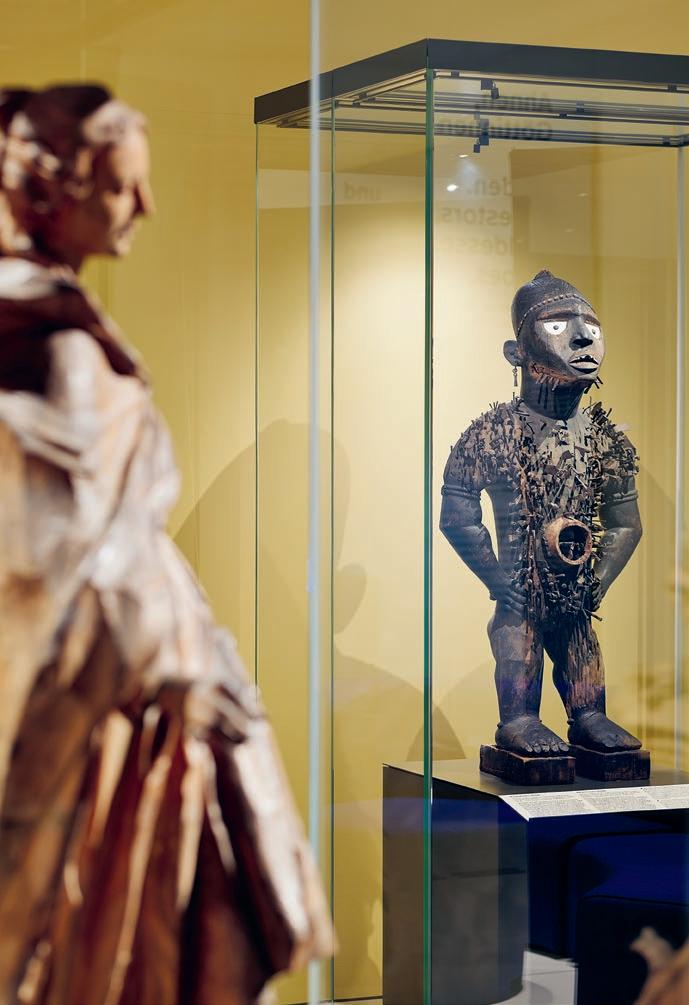



Hartmut Dorgerloh and Lars-Christian Koch
What connects the forty-five visibly heterogeneous objects assembled here in the Humboldt Forum’s temporary exhibition ANCESTORS, GODDESSES AND HEROES? What is the common thread, the conceptual category, that for all their differences, they all share? Is this equating of the unequal not just a flight of fancy – an idea adopted from a great distance?
Well, let’s find out, first by moving closer and then by taking a step back. What first catches the eye is just how unalike the selected works are. They were created in completely different periods ranging between the third and the nineteenth century, and in vastly different cultural spheres spread over three continents, namely Central Africa, East Asia and Western Europe. Never before have they been seen in this particular constellation.
So what, stepping back to view them from a greater distance, are their points in common? Three of these can be named, although there are probably many more. First, all the objects come from Berlin collections, namely those of the Ethnologisches Museum, the Skulpturensammlung and the Museum für Byzantinische Kunst der Staatlichen Museen zu Berlin; second, they are united by their erstwhile function, since every one of them was born of the universal human need for protection, guidance and security; third, they share the same fate in that they are all ‘orphaned’ ritual objects that have been removed – often by force –from their original functional context.
Instead, these figures have become museum exhibits for us viewers to look at, and that our own encounter with them is motivated by interests and expectations very different from those of their makers goes without saying. So how do these mute ritual objects engage with us as people of the twenty-first century? What can they tell us about their origins and the transformations they have undergone? Have they retained any of their original pow-
ers? Or are they simply precious artifacts? Are they images or icons? Heroes or intermediaries?
The temporary exhibitions staged by the Stiftung Humboldt Forum im Berliner Schloss in collaboration with the Staatliche Museen zu Berlin and other partners turn the spotlight on the transcendent aspects of the cultural spheres in which we operate. ANCESTORS, GODDESSES AND HEROES: SCULPTURES FROM ASIA, AFRICA AND EUROPE is a joint project by a cross-institutional team of curators from the Ethnologisches Museum, the Skulpturensammlung and the Museum für Byzantinische Kunst, both of the Staatliche Museen zu Berlin, and the Stiftung Humboldt Forum im Berliner Schloss, to all of whom we extend our sincerest thanks.
We now have the pleasure of inviting you to view these forty-five emissaries of distant times and cultures and to let them steer your thoughts into illuminating new realms.
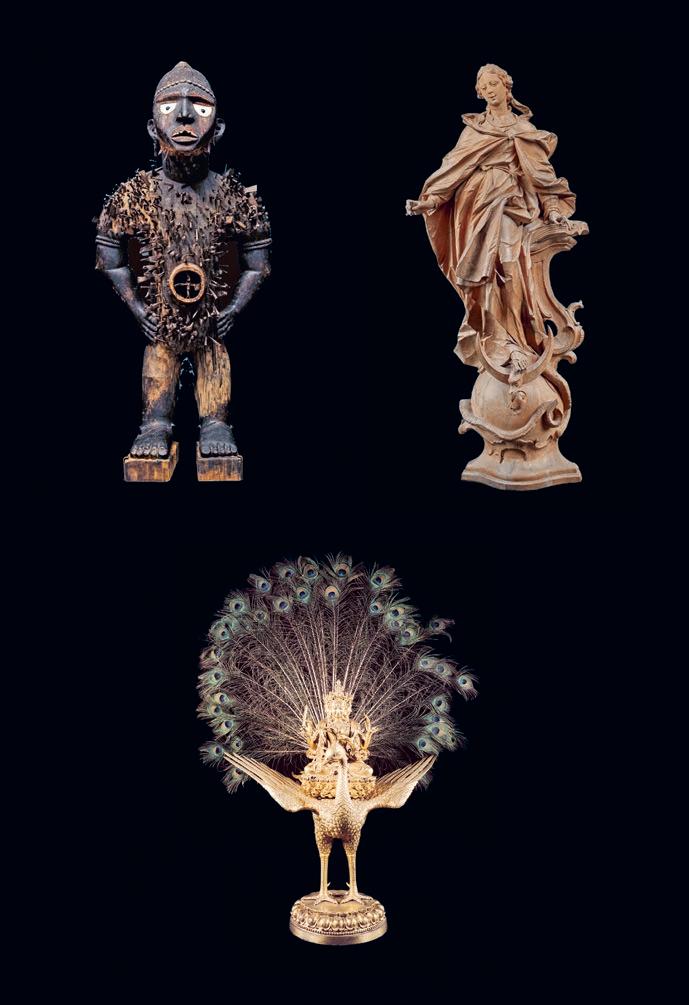
Tanja-Bianca Schmidt, Nathalie Küchen, Barbara Lenz
ANCESTORS, GODDESSES AND HEROES
shows selected works of art from Central Africa, East Asia and Western Europe exhibited alongside each other for the first time. Despite the obvious differences between them, the works are united by one fundamental aspect: they all played a key role in cultural practices and were central to overcoming both individual and societal crises. They stand for the presumed existence of an invisible world of gods, spirits and ancestors, and helped forge a palpable link between this world and a ‘different reality’. Through the powers ascribed to them, they provided security and guidance, averted perils and punished rule breakers. They enlisted the intercession of ancestors, divine beings or the ‘one true God’, or were a source of inspiration at the personal level.
The exhibition’s three key works demonstrate the unshakeable conviction with which people of different periods and on different continents invested sculptural figures with the power to protect, heal or punish.
on the earth turns on the idea of freeing the world from original sin. Such Marian icons carry great emotional weight for millions of Christians, who derive hope and comfort from them to this day.
The forty-five exhibits dating from the fourth to the nineteenth century are drawn from three different Berlin collections belonging to the Staatliche Museen zu Berlin: the Ethnologisches Museum, the Skulpturensammlung and the Museum für Byzantinische Kunst der Staatliche Museen zu Berlin. The collective contemplation of such disparate works prompts a discussion that goes to the very heart of what institutions dedicated to collecting, preserving and categorising actually do, exposing the divisions that this exhibition seeks to transcend.
The study of these objects takes us deep into the early days of the Staatliche Museen zu Berlin, which began with the gradual dispersal of the Brandenburgisch-Preußische Kunstkammer and the reallocation of its holdings to the specialist museums founded by royal decree between 1830 and 1930.
Fig. 1–3 The three key figures in the exhibition Ancestors, Goddesses and Heroes
To the communities living along the Loango coast in today’s Democratic Republic of Congo and Angola, the sculpture from Africa, a NKISI NKONDI, was both a visible manifestation of MANGAAKA, or jurisdiction, and a concrete response to the ever greater threat posed by the European colonial powers. The Asian work, a MAHAMAYURI , is venerated from India to China, its place of origin, as the tutelary god that affords protection against natural disasters. The third work was created in eighteenth-century Europe and comes from a church in Bavaria. The iconography of its depiction of the VIRGIN MARY standing
The Königliches Museum (now the Altes Museum, Museumsinsel) that opened in 1830 was the first museum in Berlin to be open to people ‘of all classes’.1 It housed parts of the Brandenburg art collection, including numerous European paintings and sculptures. Most of these dated from Antiquity to the Renaissance and were judged to be ‘high art’ that warranted presentation in a building whose architecture combined stylistic elements from both periods. The carefully composed overview of art history provided by the galleries of this egalitarian educational institution served primarily to enable an aesthetic appreciation of the works and to foster in visitors a socially defined sense of taste. Closely bound up with this was the striving of the upwardly mobile middle classes to educate themselves and through art to train their intellectual powers of discrimination and discernment, as envisaged by Wilhelm von Humboldt.
The Neues Museum, which is also located on the Museumsinsel and opened twenty years later in 1850, was intended to provide a counterweight to the art-historical bias of the neighbouring collection. In its eagerness to present a suggested cultural evolution of humanity from 1859 onwards for as broad an audience as possible, it exhibited items of relevance to the history of culture, including everyday objects, weaponry, textiles and ‘ritual figures’, and extrapolated from these a narrative that was erroneously premised on the existence of ‘natural’ differences between peoples based solely on skin colour, which in a sleight of hand was equated with the different stages of development so far reached. The presentation of cultural artifacts ultimately followed Friedrich Hegel’s teleological view of history, meaning that visitors were led from the ‘lower’ to the ‘higher’ cultures, that is, from the Egyptian, prehistoric, and ethnological collections on the ground floor to the plaster casts of Ancient Greek and Roman sculpture and Europe’s early modern period on the first floor. This powerful staging of a eurocentric view of history created the impression of a ‘natural’ hierarchical order with the ‘white man’ at the top, which of course was very useful to concurrent efforts to forge a national identity as well as supply a justification for colonialism.
Germany’s colonial expansion, which entailed not only opening up new geographical regions and with them new markets and opportunities for trade, but also conceptualising what culture actually is or should be, reinforced the white Europeans’ sense of their own cultural superiority. The structures established by colonial governments or even just diplomatic relations in the occupied territories also empowered colonial players on the ground.
As ever more cultural creations from all over the world were amassed, so still more museums were built to house them. Amongst these was the Königliches Museum für Völkerkunde (now the Ethnologisches Museum) on Königgrätzerstrasse (now Stresemannstrasse) which opened in 1886 and provided space for both the prehistoric holdings and the now vastly enlarged ethnographic collection comprising
works from Oceania, Africa, Mesoamerica and North America. Prior to its demolition in 1961, it stood in the immediate proximity of the Kunstgewerbemuseum (Museum of Arts and Crafts) that opened in 1881 in the purposebuilt Martin-Gropius-Bau. The objects from East Asia, by contrast, were judged to be works of art, which led to the 1906 opening of the Ostasiatische Kunstsammlung. While this institution was initially housed in a partitionedoff section of the Völkerkundemuseum, in 1924 it was moved to permanent premises of its own on the ground floor of the Kunstgewerbemuseum.
The early days of the twentieth century saw the Museumsinsel endowed with yet another new building, the Kaiser-Friedrich-Museum (now the Bode-Museum). This housed many of the European paintings and post-antique sculptures from the Altes Museum, which it grouped together with craft objects, furnishings and architectural elements in tightly packed ensembles designed to evoke the mood of a particular epoch. Finally, the addition of the Pergamon Museum, which as of 1930 housed the collection of ancient architecture, the Department of the Ancient Near East, the Department of Islamic Art and the Deutsches Museum, turned the Museumsinsel into a storehouse of ‘civilisation’ that brought together works of art from Europe, the Mediterranean and Mesopotamia (now Iraq and north-eastern Syria).2
What the museum concepts described here resolutely ignored was that the three continents from which the works were drawn, namely Africa, Asia and Europe, had been closely intertwined by trade relations, not least by the Trans-Saharan trade route that until 1590 linked West Africa to the Mediterranean, to name just one example. Ideas and religions followed the same routes as the commodities, reaching even very remote regions. Buddhism, for example, travelled along the Silk Road from India to China and Japan (115 BCE–13th cent.). In the
Fig. 4 Exhibition of the African Collection at the Königliches Museum für Völkerkunde at Königgrätzer Straße (today: Stresemannstraße) 120, corner of Prinz-AlbrechtStraße (today: Niederkirchnerstraße), photograph taken before 1926
Fig. 5 Exhibition of the Gemäldegalerie and Skulpturensammlung at the KaiserFriedrich-Museum, Room 36, Italian bronzes of the 16th century, photograph c. 1917


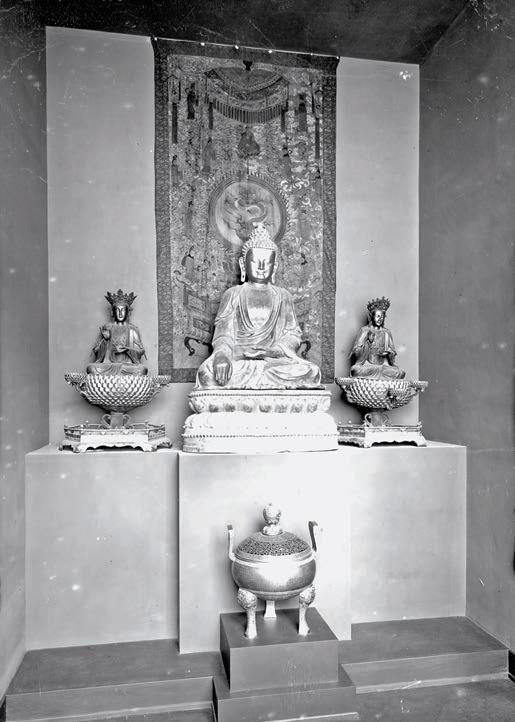
‘universal collections’, Kunstkammer and cabinets of curiosity amassed by the elites long before the advent of public museums, these long-standing ties had coalesced into models of a worldview that regarded nature, culture, art and science as different aspects of a single whole.3 The vast collection of the Berliner Kunstkammer housed on the first floor of the Berliner Stadtschloss, for example, com -
Fig. 6 Chinese Buddhism exhibition at the Ostasiatische Kunstsammlung at Prinz-Albrecht-Straße (today: Niederkirchnerstraße)
prised an eclectic array of objects whose primary purpose was to demonstrate the encyclopaedic knowledge and global reach of the Brandenburg electors. That endeavour was supported by the principle of equivalence, according to which natural and artificial objects as well as everyday objects and utensils were to be shown alongside each other as of equal value. This idea of staging a supposedly
universalising context for unequal things was nevertheless jettisoned at the founding of Berlin’s first museums.
Museum exhibitions, which steer their audiences’ attention, choreograph their visits, propose meanings, shape worldviews and dictate cultural concepts, can still be described as orderings of knowledge even today. In the past, our perception of non-European cultures was framed by a complex scholarly apparatus, whose quasi-evolutionary, social-Darwinist theories seeped deep into the social consciousness and influenced our worldview with lasting effect.4 The spatial separation of objects enforced on the basis of seemingly objective criteria supported the dogmatic distinction between ‘primitive’ and ‘civilised’, which still informs the hierarchical perception of our material heritage propagated by many museums even now. Similarly consequential was the accentuation of cultural difference that would define perceptions of the ‘other’ right up to the present. Many of the holdings of Berlin’s museums can be traced back to the far-reaching influence of the House of Brandenburg and have since then been steadily supplemented by works from other sources. In view of the ongoing criticism of the heritage of German colonialism housed in Berlin’s museums, the Humboldt Forum believes it has a duty to address the value judgements and ideology that once underpinned the creation of the Berlin collections.
The exhibition ANCESTORS, GODDESSES AND HEROES: SCULPTURES FROM ASIA, AFRICA AND EUROPE can therefore be understood as an inquiry into the involvement and complicity of Berlin’s museums in European colonialism. Tragically, the ‘collection mania’ that took hold of the upper echelons of society conflated the amassing of objects with the accumulation of knowledge and power. This motivated the systematic expansion of Berlin’s museum collections in competition with some of the world’s other great museums, such as those in London, Paris, Chicago and Detroit. What all the exhibits shown here share is the fact that their transformation into museum exhibits has decontextualised them and hence changed them in respect of both
function and impact. Their ‘acquisition’ for the newly emergent museums of the nineteenth century was prompted by many factors and pursued with often highly dubious methods, with the result that their original authors and complex functional contexts are rarely documented.
Colonial players in far-away countries often took advantage of their power over indigenous peoples to loot countless objects that they then handed over – sometimes for a modest reward – as ‘display objects’ to the museums in Berlin. The works from Africa, for example, were added to the collection of the Ethnologisches Museum during the nineteenth and twentieth centuries, when Europe was busily laying claim to the world.
The exhibits from East Asia, many of them perceived as handicrafts in their place of origin, 5 began appearing on the international art market during the turmoil that marked the end of the Chinese empire and that culminated in the Xinhai Revolution of 1911 and the founding of the Chinese Republic (that existed from 1912–1949). Much sought-after by European collectors, these ‘Far Eastern’ artifacts, in German known as Ostasiatika, were eagerly snapped up as especially prestigious ‘trophies’. Some of the exhibits originally belonged to private collections, parts of which were later purchased by Berlin’s expanding museums. The two Buddha pupils from the estate of the collector Paul Wegener are a good example of this.
Some of the figures and objects from the Skulpturensammlung and the Museum für Byzantinische Kunst came to the museum as a result of the church’s unstoppable loss of power and influence following the Reformation and Enlightenment – some of them by force, others as a result of changing tastes, for example within the ecclesiastical elite.
The exact circumstances under which most of the works shown here were acquired nevertheless remain obscure. Even those exhibits which from the point of view of the museum were lawfully accessioned at the time of their acquisition may yet turn out to have a dubious provenance. The Spanish Pietà, for example, was a gift of a former Nazi party member,
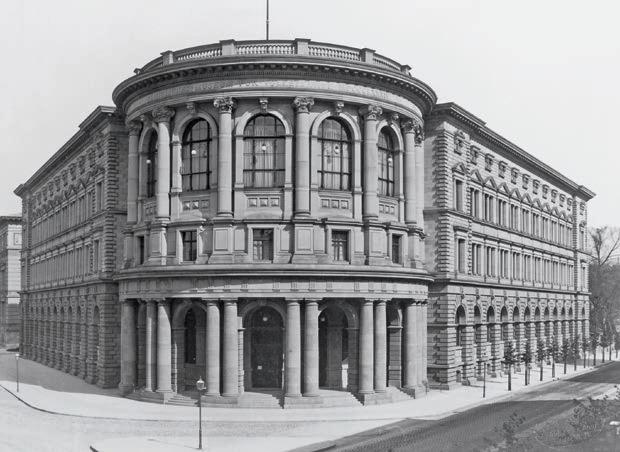
Franz Rademacher, yet we know neither where it came from nor how Rademacher came to be in possession of it | see pp. 62/63 |.
Given the objects’ complex religious, political, economic and social contexts, the question of what their original role might have been and what gaps they left behind when they were taken away must also be addressed. Notwithstanding how museums classify them, the works are neither ‘merely’ art nor are they ‘merely’ cultural artifacts. They are rather an amalgam of religion, politics, culture and aesthetics, and closely bound up with all of them.
The exhibits are presented in seven chapters titled ‘What does “protection” actually mean?’, ‘How are evil forces kept in check?’, ‘Are they all genuine?’, ‘Can a word describe a thing?’, ‘Which image is an icon?’, ‘What is in a face?’ and ‘Are all heroes alike?’ It is conceived, in other words, both as an invitation to question the thought patterns and value judgements impressed upon us by educational institutions such as museums and the me-
dia, and as a rejection of that narrative that disregards the commonalities and connections between geographically, historically and socially separate spheres. It also lays the groundwork for a sensory appreciation of the multiple worldviews on display. Our aim, in other words, was to make it possible for both areas of agreement and areas of difference to be experienced as an enrichment of our own perspective.
Fig. 7 The Königliches Museum für Völkerkunde, photograph taken before 1895
The exhibition and book would have been inconceivable without the debate over the Humboldt Forum’s handling of its ethnographic collections. The sensitive and judicious use of any such terms as might reproduce stereotypical perceptions of the exhibited objects or encourage their categorisation as ‘exotic’ was a matter of the utmost importance to the authors – and not just when writing the texts. Clearly, it was vital that the descriptions of the works enable readers to grasp the complex interaction of aesthetics and function that each embodies. Hence the focus on the
works’ aesthetic properties as well as their conceptual content and at least one aspect of their function. It is therefore with great pleasure, and anticipation, that we invite viewers to pick up any, or all, of the many different threads provided and to follow them wherever they may lead.
1 Elisabeth Weisser-Lohmann, ‘Das Nationalmuseum – Konzeptionen um 1800’, in Kunst als Kulturgut 2, ‘“Kunst und Staat”’, ed. Annemarie GethmannSiefert, Bernadette Collenberg-Plotnikov and Elisabeth Weisser-Lohmann (Munich, 2011).
2 On the concept of ‘Islamic art’ see Wendy M. K. Shaw, What is ‘Islamic’ Art? Between Religion and Perception (Cambridge, 2019).
3 Gabriele Beßler, ‘Kunstund Wunderkammern’, in Europäische Geschichte Online (EGO), ed. LeibnizInstitut für Europäische Geschichte, 2015, http:// ieg-ego.eu/de/threads/ crossroads/wissensraeume/ gabriele-bessler-kunstkammern-und-wunderkammern.
4 On the connection between museums and worldviews, see Tony Bennett, ‘Ausstellung, Wahrheit, Macht: Ein Blick zurück auf den “Ausstellungskomplex”’, in Der documenta 14 Reader, ed. Quinn Latimer and Adam Szymczyk (Munich/London/ New York, 2017), pp. 339–352; see also Tony Bennett, ‘Der bürgerliche Blick: Das Museum und die Organisation des Sehens’, in Die Ausstellung: Politik eines Rituals, ed. Dorothea von Hantelmann and Carolin Meister (Zurich/Berlin, 2010), pp. 47–77.
5 The re-revaluation of the sculptures in Europe‘s museums has changed this way of seeing, especially over the past few decades.

Provenance research in the context of museum collections entails inquiring into each object’s origin from its creation up to its current whereabouts. It sets out to ascertain how objects were appropriated and the paths by which they ended up in the museum. By providing detailed information on provenance, we hope to make these paths as transparent as possible and to share the latest research findings with you. Ideally, an object’s provenance will take the form of a gap-free, chronological list of its previous owners and/or custodians. The following definitions are intended to help shed light on the provenance information provided.
The author or authors of a work are always named, if known. In all other cases the label will say ‘Author’ or ‘Authors not documented’. We would like to stress that every object was made by a skilled artisan or artist or workshop, even if their names are now lost to us or can no longer be ascertained. There may be many reasons for this. Sometimes the name of the artist or artisan was never recorded, or it was never disclosed. Often their identity was of no concern to the people who appropriated the objects, or the source materials were simply lost at some point.
But nor are the ‘users or custodians’ of the objects known by name in most cases. Only those who are known are included in the provenance, where they are listed chronologically up to the time the object was taken into the museum. If an object has been in the same collection for decades, the museum’s historical name is mentioned alongside the one by which it is now known.
The exact circumstances under which an object was appropriated or acquired by a European user or custodian can rarely be reconstructed. The said ‘collectors’ were often colonial players, who might have been part of quasi-military, scientific expeditions or active as missionaries. Sometimes they quite explicitly procured objects to order for European museums. We regard colonialism as a context of systemic injustice.
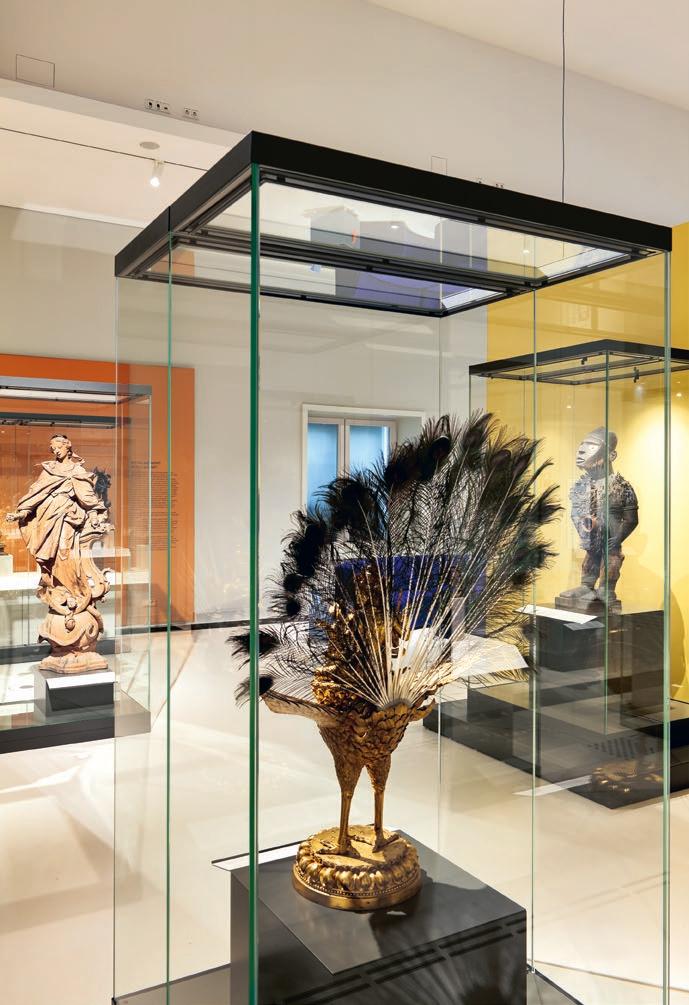
The focus here is on three works whose interpretation relates to the theme of protection. They differ as much in their formal design as in the social, religious and political roles they originally played in their respective contexts. They have in common the expectation that they would mediate between this world and another, invisible world beyond.
Their power to protect or preserve could extend as much to individuals as to whole societies. The figures of the VIRGIN MARY and MAHAMAYURI were believed to have the ability to avert disasters such as disease, drought, famine and war. The MANGAAKA, by contrast, was invoked to restore social and political stability to rival Yombe communities following the collapse of the Kingdom of Loango (now part of the Republic of Congo) in 1870, in part owing to the encroaching European colonial powers.
Museum presentations of these objects tend not to reflect the complexity of the rituals in which they were originally embedded. They would certainly have appealed to several senses at once and through the use of potent substances, prayers, meditation or performative acts might even have been brought to life, becoming active players. In museums, by contrast, they are shown as mute, stand-alone works of art or simply as testimony to a certain society. | TS, BB |
